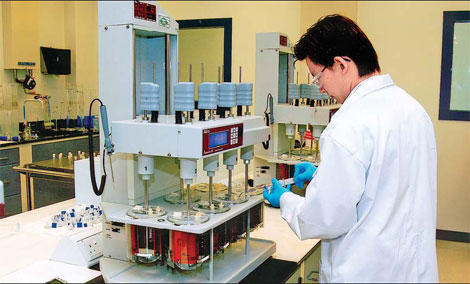Merck to put $1.5b in R&D
Updated: 2011-12-07 07:52
By Liu Jie (China Daily)
|
|||||||||
|
A Merck Sharp & Dohme (Singapore) Ltd technician samples a tablet dissolution bath in the company's bulk pharmaceutical manufacturing plant in Singapore. Bloomberg News |
Collaboration will bring China facilities into drug giant's global network
BEIJING - Merck Sharp & Dohme (MSD), the world's second-largest drug producer by sales, announced on Tuesday it will invest $1.5 billion in research and development (R&D) in China within five years.
In addition to building an Asia R&D headquarters in Beijing, some of the funds will be put into establishing collaboration arrangements with local counterparts, academic institutions and other types of partner, said Peter Kim, president of Merck Research Laboratories.
MSD is known as Merck & Co Inc in the United States and Canada.
Michel Vounatsos, chairman and president of MSD China, said that possible partners would be assessed on whether they could add value and play a complementary role.
The executives said the new R&D headquarters in Beijing could be a platform for many kinds of collaboration.
It will also bring China into the company's global R&D network, said Kim.
The first phase of construction on the R&D facility will be finished by 2014. That space will provide work areas for 600 employees.
The first phase will include the functions of drug discovery, clinical development, regulatory affairs and external scientific research programs. After completion, the headquarters will consist of 47,000 square meters of office and laboratory space.
MSD has reached a series of cooperation agreements with local partners.
It signed a research deal with Shenzhen-based BGI in September, aiming to combine the Chinese genomics research institute's sequencing techniques with a new generation of personalized therapies.
Its joint venture with Zhejiang-based Simcere Pharmaceutical Group was set up in July. And MSD has signed an agreement with State-owned Sinopharm Group Co Ltd for vaccine development and distribution.
Multinationals, which are exploring new approaches to advancing the clinical development of innovative products in China, will benefit from cooperation with local companies, according to a report from international healthcare company IMS Health.
Bristol-Myers Squibb Co has granted rights to Simcere for the development and commercialization of one of its pre-clinical oncology products.
While the US-based company retains exclusive rights in all other markets, it will work with Simcere to accelerate development and initial human studies in China by tapping into the local company's clinical and regulatory expertise and access to a large patient pool.
Pfizer Inc has entered into collaboration with MicuRx Pharmaceuticals Inc, a Chinese biopharmaceutical company dedicated to the development of antibiotics to treat drug-resistant bacteria, and domestic company Cumencor Pharmaceuticals Inc to discover therapeutic agents for multi-drug resistant tuberculosis.
Pfizer will provide an upfront payment, funding for the discovery and preclinical development, and payments linked to the development and commercialization of any antibiotics developed from the collaboration.
The Chinese government has decided to allocate 10.5 billion yuan ($1.65 billion) to the national key new drug creation program between 2011 and 2015. The funds are intended to support local R&D projects.
"So far, launches of multinationals' innovative new medicines in China are usually four to five years behind their launches in developed nations. R&D cooperation with local counterparts will help shorten the gap," said Lydia Xu, a pharmaceutical researcher at the Samsung Economic Research Institute.
Kim said that the R&D headquarters will have a role in establishing closer relations with Chinese authorities to speed up registration and approval procedures.
MSD's third-quarter global sales jumped 8 percent to $12.02 billion, the company said.
Vounatsos did not disclose the exact sales increase rate for MSD China, saying only that the rate was higher than average.
IMS Health forecast that the Chinese pharmaceutical market would achieve annual growth of 20.1 percent between 2010 and 2015, reaching 694 billion yuan by 2015.
The market will surpass Germany to become the world's third-largest by 2015, it said.
China Daily
(China Daily 12/07/2011 page15)












